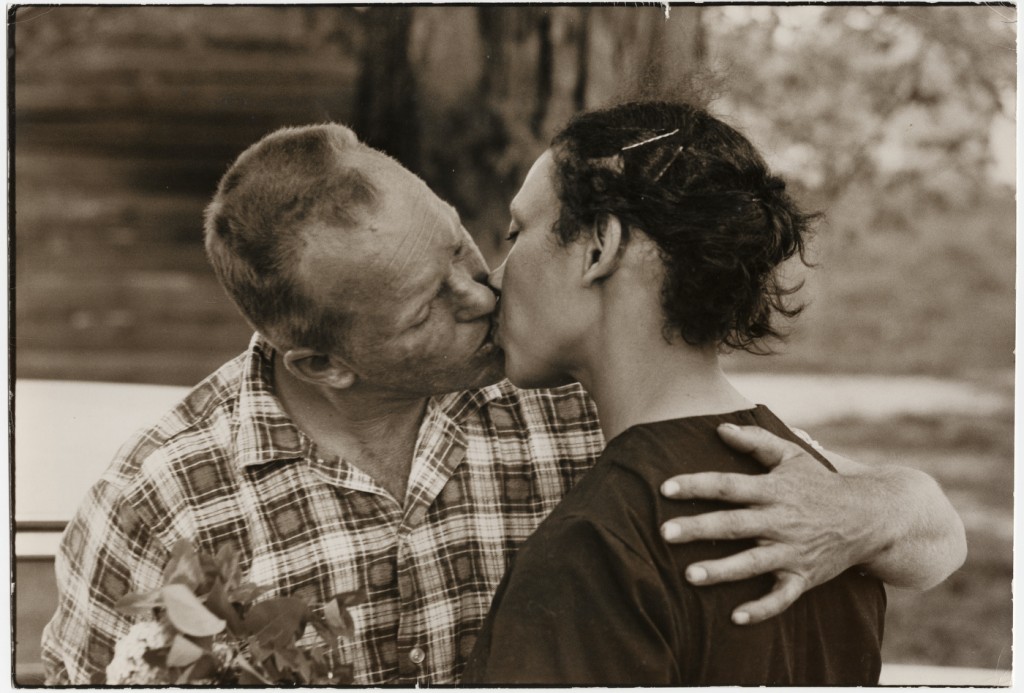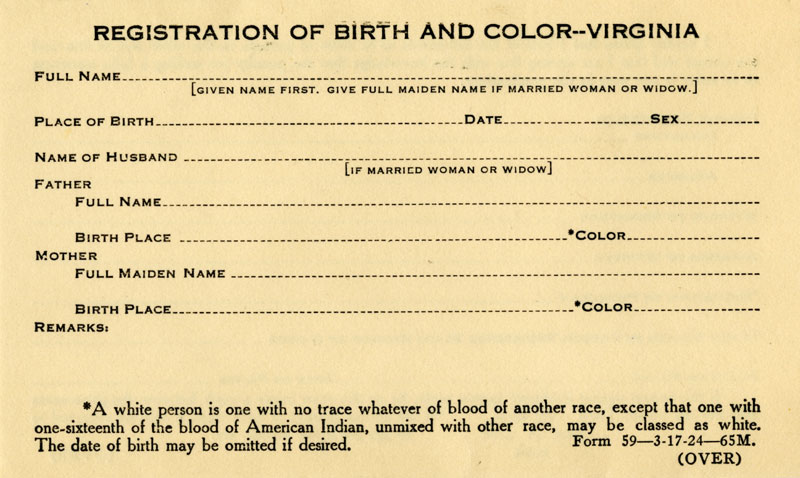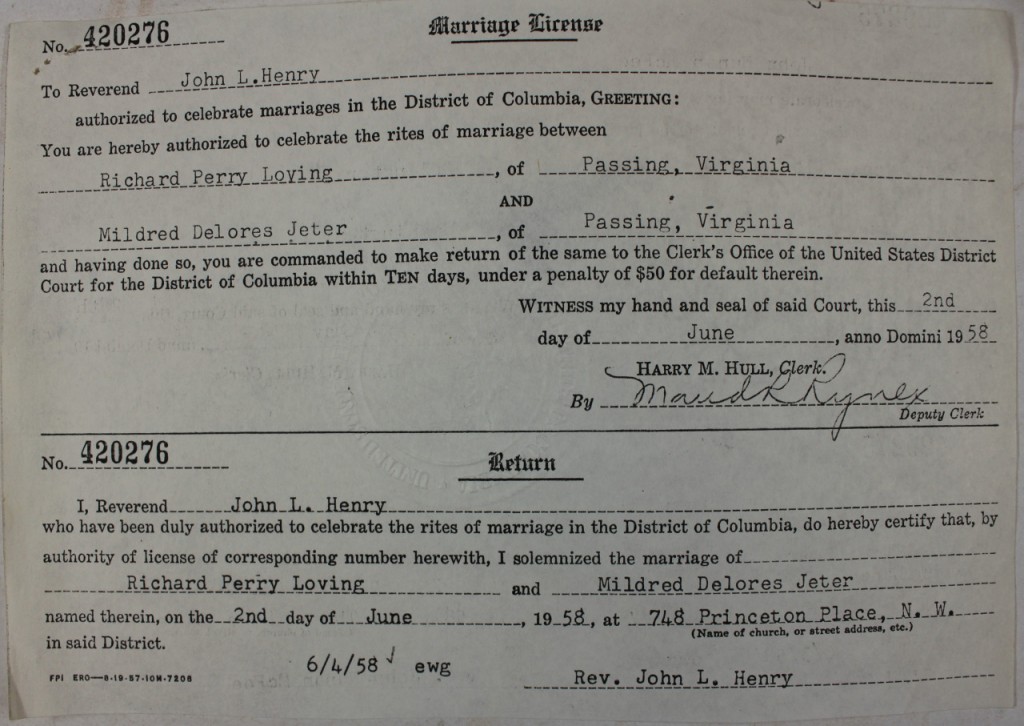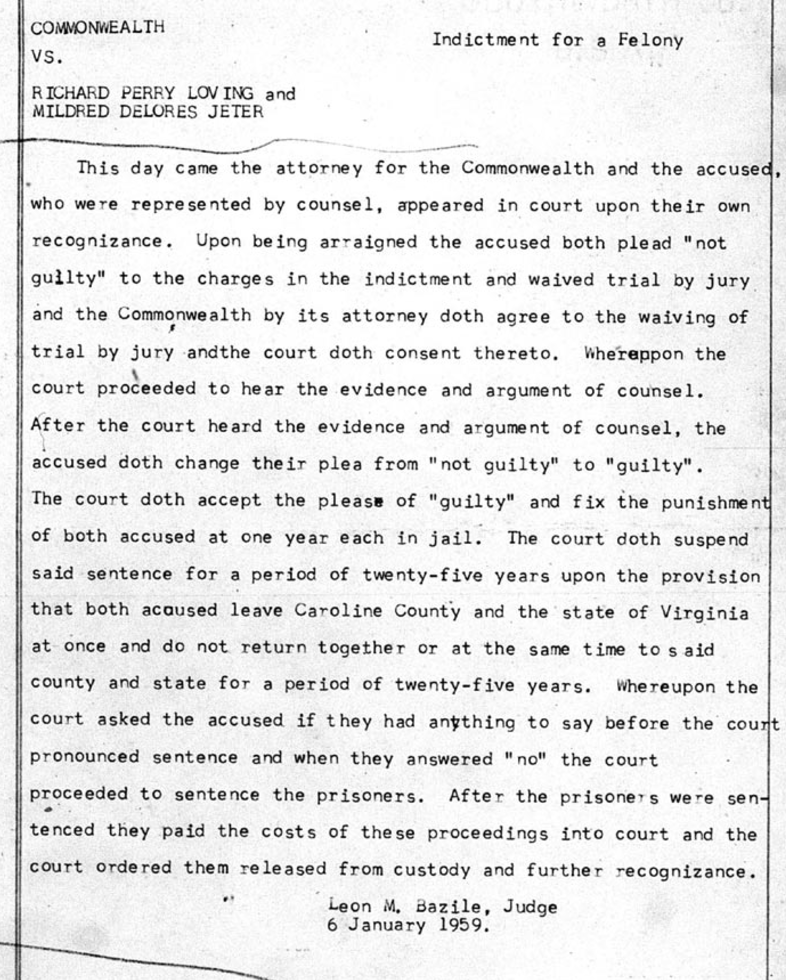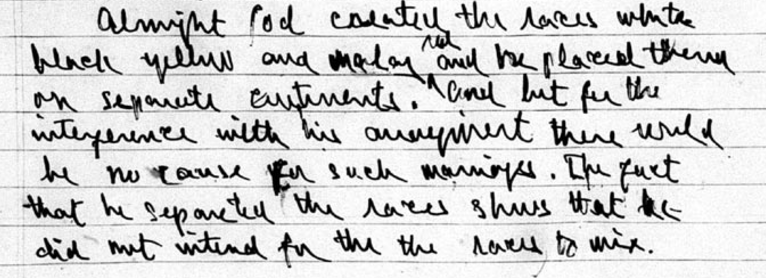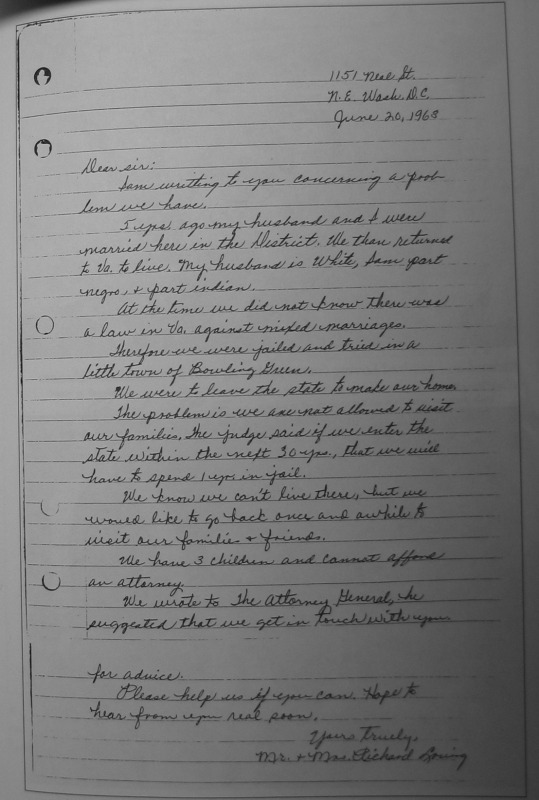Mildred Jeter of Central Point, Virginia, was only 16 years old when she became pregnant for the first time. Her child, Sidney, was born on January 27, 1957.
In June 1958, now age 18, she discovered she was pregnant again. This time the father was 22-year-old bricklayer and construction worker Richard Loving, whom she had become friends with when she was 11 and he was 17.
The couple traveled 100 miles north from their hometown to Washington, D.C., where it was legal for an interracial couple to marry. Richard was Caucasian. Mildred self-identified on the marriage application as “Indian”—specifically, Cherokee and Rappahannock, one of the ten state-recognized Native American tribes in Virginia. (Later she would also say she was “part Negro.” Years after that she would say, “I am not black. I have no black ancestry.”)
At that time, 16 states prohibited interracial marriage (Alabama, Arkansas, Delaware, Florida, Georgia, Louisiana, Mississippi, Missouri, North Carolina, Oklahoma, South Carolina, Tennessee, Texas, Virginia, and West Virginia).
Only 10 states allowed it (Alaska, Connecticut, Hawaii, Minnesota, New York, Wisconsin, New Hampshire, New Jersey, Rhode Island, and Vermont).
Virginia’s Racial Integrity Act of 1924—which passed the same day as the Eugenical Sterilization Act, allowing the state to involuntarily sterilize the mentally unfit and others—had introduced two changes for the Commonwealth of Virginia:
(1) Everyone born in the state was required to receive one of two racial designations: “white” or “colored,” with any degree, even “one drop,” of African-American or Native-American ancestry counting toward the latter—although there was a loophole for the Virginia elite who traced their ancestry back to Pocahontas and John Rolfe.
(2) The anti-miscegenation ban on interracial marriage was tightened to include criminalization for violation. Miscegenation is word coined in 19th-century America from the Latin misce[re] (to mix) + gen[us] (race, stock, species).
A week and a half after they were married, and back in Virginia, a warrant was issue for the Lovings’ arrest on July 11, 1958.
That night, at 2 a.m., Central Point Sheriff Garnett Brooks knocked and then barged into the house through the unlocked door to enter their bedroom—hoping to catch them in the marital act, which would have been an additional felony. When Brooks shined his flashlight on the sleeping couple and demanded of Richard, “What are you doing in bed with this woman?” Mildred responded, “I’m his wife” and pointed to the framed marriage license on their bedroom wall.
Brooks proceeded with the arrest, informing them the the certificate was not valid in the Commonwealth of Virginia. Miscegenation was punishable by prison.
In October, a grand jury indicted the Lovings for violating Virginia’s interracial marriage ban.
Specifically, they had violated several statues of the Virginia Code, including:
§ 20-58. Leaving State to evade law.—If any white person and colored person shall go out of this State, for the purpose of being married, and with the intention of returning, and be married out of it, and afterwards return to and reside in it, cohabiting as man and wife, they shall be punished as provided in § 20-59, and the marriage shall be governed by the same law as if it had been solemnized in this State. The fact of their cohabitation here as man and wife shall be evidence of their marriage.
§ 20-59. Punishment for marriage.—If any white person intermarry with a colored person, or any colored person intermarry with a white person, he shall be guilty of a felony and shall be punished by confinement in the penitentiary for not less than one nor more than five years.
The Lovings pleaded guilty on January 9, 1959. County Trial Judge Leon Bazille agreed to suspend the sentence of 25 years in prison on the condition that the Lovings would leave Virginia immediately and not return for 25 years. They would be permitted to return to visit their families if done separately.
Here is Judge Bazille’s famous handwritten opinion offering theological justification for anti-miscegenation:
The Lovings and their children moved to Washington, D.C.
In June 1963, Mildred Loving wrote to the ACLU about their situation, claiming to have been redirected to them through correspondence by Attorney General Robert Kennedy (though there is no documentary evidence to back up this claim).
ACLU lawyers Bernard Cohen and Philip Hirschkop took on their case and appealed it to the federal district court.
In March 1966, the Virginia Supreme Court upheld the constitutionality of their statutes and denied the appeal of the Lovings.
Cohen and Hirschkop then appealed to the Supreme Court. The Lovings did not accompany their lawyers to the court for oral arguments, but Richard Loving did give them a message to convey to the justices:
Tell the court I love my life, and it is just unfair that I cannot live with her in Virginia.
You can listen below to the full oral arguments presented:
Chief Justice Earl Warren wrote the ruling for the unanimous decision, striking down anti-miscegenation statues. Interracial marriage became legal in all 50 states.
Richard Loving died in 1975 at the age of 41, when a drunk driver struck his car. Mildred lived to be 68, dying in 2008.
Here is an ABC report on the case 50 years ago today:
Here is the trailer for a recent film on the couple and their case:
(See Arica Coleman’s analysis of what is fact and fiction in the film.)
I commend to you John Piper’s thoughtful treatment of five reasons why Christians should see and celebrate the biblical beauty of interracial message in Christ. I’ll give the reasons below, but you’ll have to read the original yourself to see him unpack the rationale for each point:
- The biblical description of how so-called racial differences emerged from one pair of human beings, Adam and Eve, shows that interracial marriage does not contradict God’s purpose for diversity in this world and the next.
- The Bible forbids intermarriage between believer and unbeliever—not between races or ethnic groups.
- In Christ, our oneness is profound and transforms racial and social differences from barriers to blessings.
- God severely disciplined the critics of one interracial marriage.
- In Christ, the good effects of interracial marriage are worth the challenges it can bring.
I also recommend J. Daniel Hays’s study, “A Biblical Perspective on Interracial Marriage,” where he concludes as follows:
[I]nterracial intermarriage is strongly affirmed by Scripture. Marrying unbelievers, on the other hand, is strongly prohibited. The criteria for approving or disapproving of our children’s selected spouses should be based on their faith in Christ and not at all on the color of their skin.
This theological affirmation should have profound implications for the church today. White families frequently rise up in arms when their children want to marry blacks, regardless of how strong their Christian faith is. On the other hand, white Christian young adults can marry other whites with little opposition even if the faith of their selected mate is virtually non-existent. Such behavior reflects the church’s weak theological understanding of Scripture on this subject.
Furthermore, the common cultural ban on intermarriage lies at the heart of the racial division in the church. White Christians who say that they are not prejudiced but who vehemently oppose interracial marriages are not being honest. They are still prejudiced, and I would suggest that they are out of line with the biblical teaching on this subject. In addition, this theology applies not only to black/white interracial marriages, but equally to intermarriages between any two ethnic groups within the church throughout the world, especially in those regions where the church has inherited strong interracial animosities from the culture at large.
The theology derived from the marriage of Moses to a black woman corresponds well with the rest of biblical theology. Genesis 1 taught us that all people are created in the image of God and have equal status before God. Paul tells us in the NT that in Christ there is neither Jew nor Gentile but that all Christians are brothers and sisters in the family of God. Marrying outside the family is forbidden, but the clear biblical definition of family is based on faith in Christ and not on race or descent. Interracial marriage between Christians is clearly supported by Scripture.
For those who seek to draw an analogy between interracial marriage and same-sex marriage, Ryan Anderson has a good reminder that bans on interracial marriage, unlike prohibition on same-sex marriage, actually had nothing do with with the very nature of marriage itself:
Bans on interracial marriage and Jim Crow laws . . . were aspects of an insidious movement that denied the fundamental equality and dignity of all human beings and forcibly segregated citizens. When these interracial marriage bans first arose in the American colonies, they were inconsistent not only with the common law inherited from England, but also with the customs of prior world history, which had not banned interracial marriage.
Commenting on these prohibitions, Harvard University history professor Nancy Cott argues:
It is important to retrieve the singularity of the racial basis for these laws…. the English colonies stand out as the first secular authorities to nullify and criminalize intermarriage on the basis of race or color designations.
America’s history of race-based chattel slavery explains the origins of these laws. This history shows that bans on interracial marriage had nothing to do with reasoning about the nature of marriage itself.
Anti-miscegenation laws were part of a much larger regime that denied human equality in order to hold a race of people in a condition of economic and political inferiority and servitude. They had nothing to do with the nature of marriage. At their heart was a mistake about the dignity of all human beings.
Francis Beckwith also has a helpful explanation of why, unlike the case with same-sex marriage, at common law there was no ban on interracial marriage:
[A]nti-miscegenation laws were not part of the jurisprudence that American law inherited from the English courts. Anti-miscegenation laws were statutory in America (though never in England), first appearing in Maryland in 1661 after the institution of the enslavement of Africans on American soil. This means that interracial marriage was a common-law liberty that can only be overturned by legislation. . . .
. . . The overwhelming consensus among scholars is that the reason for these laws was to enforce racial purity, an idea that begins its cultural ascendancy with the commencement of race-based slavery of Africans in early 17th-century America and eventually receives the imprimatur of “science” when the eugenics movement comes of age in the late 19th and early 20th centuries. . . .
Anti-miscegenation laws, therefore, were attempts to eradicate the legal status of real marriages by injecting a condition—sameness of race—that had no precedent in common law. For in the common law, a necessary condition for a legitimate marriage was male-female complementarity, a condition on which race has no bearing.













